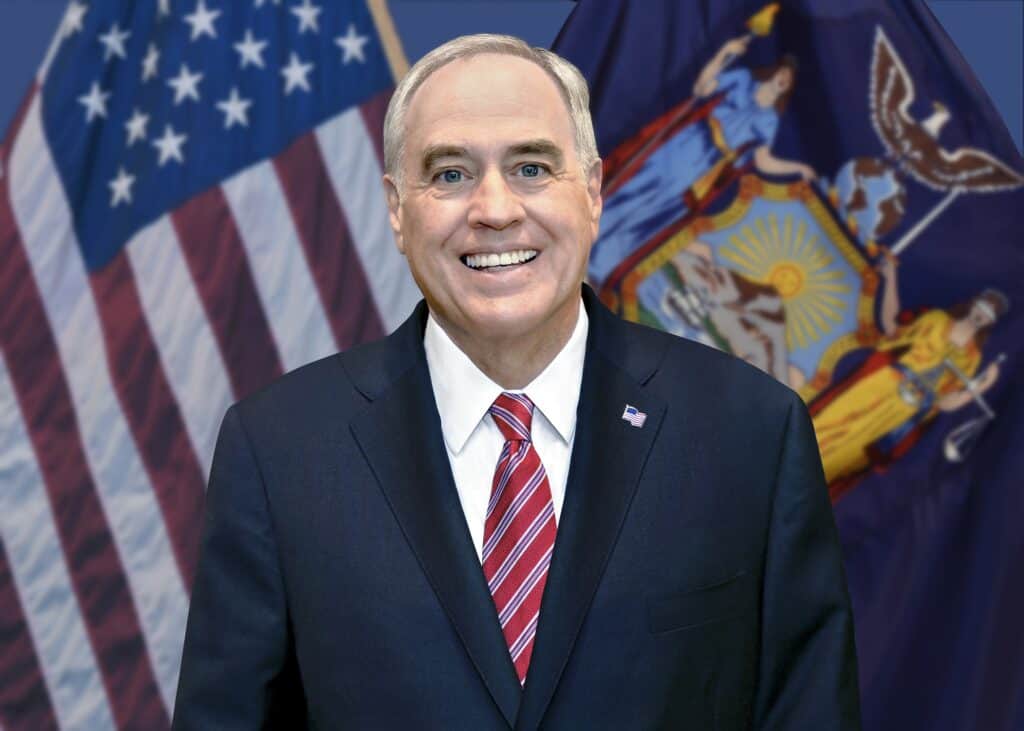
NYS Comptroller Tom DiNapoli
State Spending Up-Revenues Down-and COVID Federal Funds Coming to an End Just a year after the Division of the Budget forecast fiscal stability and no projected budget gaps in the State Fiscal Year (SFY) 2022-23 Enacted Budget Financial Plan, the SFY 2023-24 plan shows looming gaps cumulatively totaling $36.4 billion through SFY 2026-27. Reasons for the deteriorating fiscal outlook include declines in revenue from a weaker economic forecast, stock market volatility, and increases in recurring spending, according to a report by State Comptroller Thomas P. DiNapoli.
“The state’s fiscal outlook has changed considerably over the past year, and significant economic and fiscal risks could further upend the state’s finances,” DiNapoli said. “The Governor and the Legislature prudently increased New York’s reserve funds, but that cannot replace fiscal discipline or be relied upon to plug recurring budget gaps. While there is no quick fix, a proactive approach by state leaders to align recurring revenues with recurring spending could help preserve the economic competitiveness of our state and avoid cuts to critical programs New Yorkers rely on.”
DiNapoli said large budget gaps underscore the importance of building up rainy day reserves and enhancing criteria for their use. At the end of SFY 2022-23, statutory rainy day reserves totaled $6.3 billion. The Enacted Budget Financial Plan states future deposits will be made at the discretion of the Executive. Given the size of the estimated gaps and risk of economic downturn, DiNapoli recommends beginning to transfer the $13.2 billion in fund balance designated by DOB for “economic uncertainties” and controlled by the Executive into the statutory rainy day reserves on a monthly basis over the course of the fiscal year.
Growing Budget Gaps:
In the three months between the release of the SFY 2023-24 Executive Budget Updated for the 30-Day Amendments and the SFY 2023-24 Enacted Budget Financial Plan, DOB’s budget gap projections grew by $4 billion in SFY 2024-25, $5.3 billion in SFY 2025-26, and $6.3 billion in SFY 2026-27. The gaps are now projected to be $9.1 billion, $13.9 billion and $13.4 billion, respectively. The estimated gaps are well above typical forecasted levels over the previous 15 years.
The updated financial plan reduced General Fund tax receipts from the SFY 2023-24 Executive Budget estimates by more than $5 billion annually. In addition, more than $1.1 billion of average annual recurring spending was added. The projected budget gaps would have been larger, but were offset by discretionary actions taken by DOB, including adjustments to the timing of payments and prepaying future expenses. Without these actions, DOB’s projected cumulative gap over the four-year financial plan period would have totaled $48.9 billion.
Spending Up, Revenues Down
While State Operating Funds revenues are projected by DOB to decline by more than 10% from SFY 2022-23 through SFY 2026-27, projected expenditures are expected to grow by almost $22 billion, or 17.8%.On an All Funds basis, which captures the impact of waning extraordinary federal aid from the pandemic, DOB projects that receipts will decline by 5.3% during this period, while expenditures will grow by 10.3%. All Funds health disbursements are projected to grow by almost $16 billion between SFY 2022-23 and SFY 2026-27, comprising more than 70% of the projected growth for this time period. That growth is largely due to a projected rise in Department of Health Medicaid costs of nearly $10 billion (from $77.4 billion to $87.3 billion) and of $4.3 billion in the Essential Plan (from $6.3 billion to $10.6 billion).
DiNapoli’s report identifies several risks and concerns related to DOB’s forecast and projections, including the following.
Increasing Volatility in Tax Collections:
As one of its largest revenue sources, the state is highly dependent upon the Personal Income Tax (PIT). In the past ten fiscal years, collections from the PIT averaged 62% of All Funds tax revenues and nearly half of total State Operating Funds receipts. PIT receipts can fluctuate from year-to-year since they are partially based on volatile income sources such as capital gains, dividend and interest income, and bonuses paid to securities industry employees.
In 2022, DiNapoli noted that increased tax rates on high-income earners would likely make PIT collections more volatile. PIT liability is largely paid by a relatively small number of taxpayers who also have a higher share of non-wage income, like capital gains and dividend and interest income, that makes state tax collections especially vulnerable to declines in the stock market. Based on preliminary tax year 2021 data, taxpayers with incomes over $1 million were 1.5% of all filers but paid 43.5% of the total liability. Their share of those non-wage income sources was 74%.
DiNapoli’s 2022 report on taxpayer migration showed that from 2015 to 2019 a net average of 28,700 personal income taxpayers moved out of New York annually, many of whom were high-income residents. In 2020 a net of 112,400 taxpayers moved out, nearly four times as many in 2019. According to preliminary 2021 tax year data, the net number of taxpayers moving out of New York declined but was over 10,000 higher than the annual average for 2015 to 2019.
End of Pandemic Federal Aid:
The federal American Rescue Plan Act of 2021 provided $12.75 billion in State and Local Fiscal Recovery Funds to New York state. Over the two years, approximately one-quarter of funds were used for public health and safety payroll, and more than half (almost $4 billion) was for “government services.” This high-level reporting provides little specificity and explanation for use of the funds, including whether it is for recurring or non-recurring items. If these funds are supporting recurring spending, they may cause a “fiscal cliff” when funds are depleted. Future updates from DOB should be more specific about the uses of these funds.





